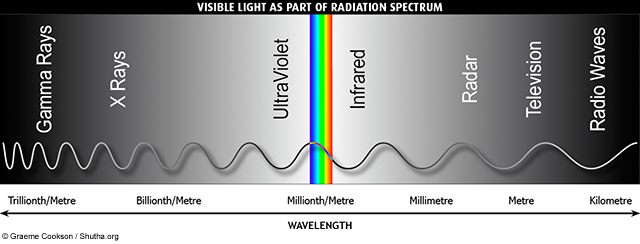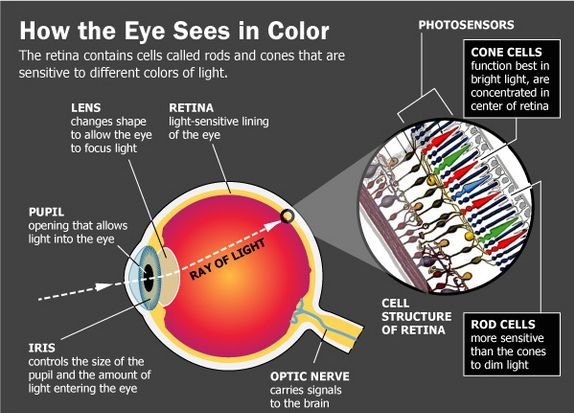According to scientists, colors are the range of light that can be seen.
In the above image, we can clearly see the different colors but Have any of us ever wondered, how actually can we see the colors??
Hello Dear Steemians!!
In this article, we shall be knowing little bit about the general concept behind How we perceive colors.
As we all know, light is a type of wave and the color is the frequency of light waves it reflects. The electromagnetic spectrum ranges from high-energy light waves with short wavelengths (cosmic and gamma rays) to low energy light waves with long wavelengths (radio waves). The light which we can see are the visible light spectrum.

The high-frequency light waves appear violet, light waves of low frequency appear red, and in between the frequencies appear blue, green, yellow, orange, and so on in visible light spectrum. The violet light has a minimum wavelength of about 400 nano meters and red light has a longer wavelength of about 650 to 700 nano meters. But how do we perceive the visible light spectrum?
In order to understand this, first of all we have to understand a bit about biology, and how humans see color.

(credit-youtube.com)
The light bounces off an object into our eyes, then it first hits the cornea (a thin film on top of our eyes) which bends light towards the pupil. The pupil then dilates or contracts to let in more or less light. The light through the pupil is sent to the lens, which angles and focuses the light to a point on the outer layer of the retina. The light sensitive cells called rods and cones then send information to ganglion nerve cells in the inner retina to the optic nerve to the brain, where the signal is processed and interpreted.

There are two types of light sensitive cells Rods and cones which are located on the outer retina and they have different jobs.
Rods are highly concentrated on the edge of the retina and transmit mostly black and white information to the brain. They are responsible for our perception of light and dark and our peripheral vision.
Cones are found in the center of the retina, where light is focused which allow us to see color. Cones come in three varieties, each sensitive to a different light. These cells, works in combination with connecting nerve cells helping the brain to interpret and name colors.
Lets talk with example.

Lets say we have an apple. When the light hits the apple, it absorbs some of the light and reflects rest of it. For an apple, it is absorbing every color except the color of wavelength of about 650-700 nm which is red. Thus we perceive it as red. Similarly, if any object looks blue, it is absorbing every color except blue.
CONCLUSION
Color is not innate to objects. Rather, the surface of an object reflects some colors and absorbs all the others. We perceive only the reflected colors i.e. when we look at something, what color we see is determined by the wavelengths of the reflected light. An object appears white when an object reflects all wavelengths and when it absorbs all of them, it appears black.
So, this is it for today. If you liked my content, Please don't forget to upvote, comment, resteem and follow me for more.


What kind of wavelenghts do beautiful people have ? (confused)
Anyway,
Thanks for the good science article brother ! Now i am getting some science knowledge from you ! Hope to see more of it. I followed you.. Keep smiling !
glad you liked it :) Thanks And following you back. I hope i will be getting some humour from you ;) ;)
#epic
Properties of matter such as temperature and microscopic structure determine the wavelength of light that matter absorbs. White light, from the Sun for example, contains light of all wavelengths which are each either absorbed or reflected at an object's surface. Unabsorbed light is instead reflected, and it is this reflected light that reaches our retina (minus any absorbed wavelengths). Human skin absorbs light of such a wavelength that the remaining light mixture appears pale in some, and darker in others (thanks to the varying concentration of the pigment melanin in the skin). Hope this helped. Very nice article too, @kelvanis.
Interesting primer on color and perception. I was hoping however, that you'd go a bit further and expand on the topic like this article:
http://science.howstuffworks.com/impossible-colors.htm
Now that is a brain-twister. Apparently it can be done, which is very interesting.
This is real cool stuff.. thanks you guided me to it :) Interesting !!
Amazing this post @kelvanis. Much more information I didn´t know it. Thanks so much for sharing this, I´m sure it will be useful for me. Greetings!
Thanks mate!! very glad u found it informative :) cheers
You are welcome @kelvanis :)
Amazing, would love to learn about color blindness aswell!
Thanks .. :) Here is the post on colour blindness u might be interested in :) :)
https://steemit.com/medicine/@alpharay/colorblind-vs-normal-vison-everythings-you-need-to-know-about-color-blindness
I always wonder how do we see different colors, this post helped me to get this. Hope you will post more.
I have followed you.
THANK YOU> BUDDY..
Thanks buddy :)
Your post was mentioned in the hit parade in the following category:Congratulations @kelvanis!
Thank you @arcange :)
Thanks a lot @steemiteducation :)
Are you familiar with the work of James Clerk Maxwell? I was aware of his equations of electromagnetism but wasn't aware of his work on color perception until very recently.
https://en.wikipedia.org/wiki/James_Clerk_Maxwell